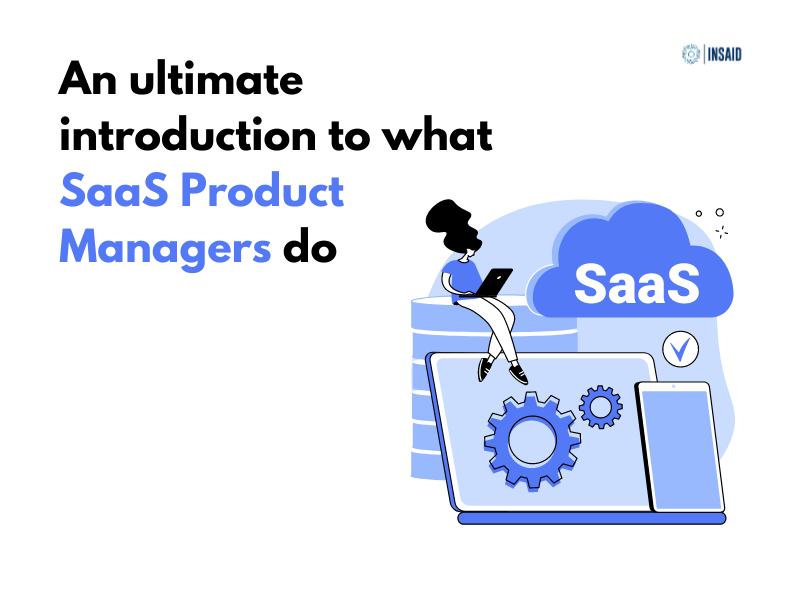The SaaS product manager role is one of the fastest-growing roles in the entire software product development realm. This makes you wonder, what does a SaaS product manager do, that makes their role so valuable to SaaS companies.
If you’re looking to start a career in SaaS product management, keep reading. In this article, we’ll go over what SaaS product managers do and the top 10 responsibilities of a Saas product manager.
Let’s dive right in.
What Does a SaaS Product Manager Do?
A SaaS product manager oversees new products from their conception to launch, along with each new iteration. In other words, they’re the point person throughout the entire product lifecycle, from the product strategy phase to the go-to-market phase.
They develop a product roadmap for the entire product team, ensure seamless product functionality, decide on backlog prioritization, and take the product vision towards completion.
Some full-time senior product managers working at a SaaS business may also be responsible for multiple cross-functional product teams.
On the other hand, some companies may have their managers oversee UX (user experience) designs and even some aspects of product marketing operations.
Responsibilities of a SaaS Product Manager

Product management has evolved into a diverse job and each company has somewhat distinct responsibilities associated with it.
However, some responsibilities are a prerequisite for the role.
Here are the 10 main responsibilities that every SaaS product manager will have to deliver on at some point in their career:
1) Create a Product Strategy
The foundation of a great product is a solid strategy and the product manager is often solely responsible for it.
Mostly it’s the manager who creates a strategy outline, circulates it around the primary stakeholders, fleshes it out with their feedback and makes it the basis of customer success.
Depending on the complexity and scope of the product, as well as the number of different positions involved, the strategy may be divided into segments or developmental stages.
It would be the manager’s job to make sure each stage is completed and each new feature is implemented as planned and within the deadline.
2) Conduct Market Research
The B2B SaaS business model depends on extensive market research to succeed. This is due to the ever-changing product-market fit metrics and customer demands.
A typical manager would either create a list of market research parameters and hand them over to dedicated research and data professionals or take care of it themselves.
Either way, looking at the market to determine the product backlog and features is a critical part of the PM role.
Additionally, some companies may also hire PMs with a Data Science background. In this case, the majority of that PMs time would be spent analyzing the market.
3) Generate Product Ideas
The majority of the idea generation comes either before or directly within the product strategy creation phase.
However, some companies may have PMs working on new ideas throughout the pre-development stages of the life cycle.
In the latter case, the manager would assemble a brainstorming team consisting of major stakeholders from each of the departments involved with the product. They would then think of creative ideas based on the results of the market research.
If there already is a set of ideas, the PM would focus on improving existing ones.
4) Oversee Product Design
The product manager role is inherently focused primarily on the development side of things. However, some companies, especially startups operating in the SaaS space, also involve PMs in product design.
Here, a PM would have to brainstorm design elements during the idea generation phase, analyze customer feedback on previous iterations or competitor products, and finalize a design to be implemented.
If the manager got promoted from a design job to their current position, they may be more involved with the design side rather than development, strategy, and/or marketing.
5) Collaborate with Other Departments
Agile SaaS companies have several departments, all of which collaborate and work together to build a better product and achieve early delivery on it.
Product managers are often the center point for collaborations, with each department referring to them for guidance and coordination.
A lead product manager would have this responsibility compounded since they’re responsible for a wider range of teams that are working on a product.
The DevOps philosophy is built on this sort of collaboration. In a company that adheres to DevOps principles, the product manager may be responsible for implementing them on the product side.
To understand these points with ease and many visual aids, check this video!
6) Coordinate Between Departments
PMs often have to act as liaisons between various departments. For example, a manager could be responsible for taking instructions or strategic initiatives from the board of directors or executives and relaying them to the developers. They could also pass on some feature-related talking points to the marketing department.
Some bigger companies have dedicated product coordinators that work in this capacity. However, since most SaaS companies are on the smaller, less well-staffed side, it’s the product managers who often have to take over the coordination.
7) Cultivate Relationships with Partners
Some SaaS firms have customers that partner with them for extensive, large-scale software usage. These customers usually have hundreds or even thousands of users.
Such a large number of users often requires customized software solutions which SaaS firms often accommodate. Most of the time, this requires a deeper partnership that the manager has to establish directly.
Once the agreement has been made, a manager would then modify the product feature repertoire. Or perhaps increase the existing usage bandwidth of the product to suit the customer’s needs.
Keep in mind, this responsibility only comes into play when the company allows provisions for bigger clients.
8) Keep Major Stakeholders Informed
Every company has C-level executives or a board of directors that the managers need to answer to. The product manager’s responsibilities extend further to include timely reports and reviews.
The manager has to keep the company leadership informed at various points in the product life cycle, such as:
- When creating the product strategy
- When finalizing the list of features and pricing
- Before and after testing the product
- During the review period after its launch
Depending on the host company, a manager’s reporting duties may vary. However, there’s always some level of reporting that managers have to adhere to.
9) Implement a Streamlined Product Launch
The initial product launch decides how the wider customer base reacts and interacts with the product. This is one of the reasons why the launch is one of the riskiest stages of the SaaS product lifecycle.
A manager works to streamline a product launch by coming up with a product launch strategy and roadmap, implementing CRM, sales, marketing, and project management tools. They also have to assign the appropriate responsibilities to each of the departments involved.
Additionally, a manager has to maintain a launch timeline that accounts for all of the aforementioned activities.
Depending on the team structure and size of the workforce the manager may delegate certain timekeeping tasks to junior managers.
10) Train New Staff
Since the manager is the de-facto field leader of the product team(s), it’s their responsibility to provide on-site training to new recruits.
Senior managers may put together training material and resources for each new hire, or even take them through the onboarding process, in the case of smaller startups.
Some of the technical staff, such as members of the engineering teams, may undergo training under the care of their superiors in their relevant team. However, the manager will still have training oversight duties.
 Pin
PinIf you’re looking to get the skills to excel in this role, then check out our product management program here.
Read more such blogs here. Explore our A-Z blog page for even more product management insights.






